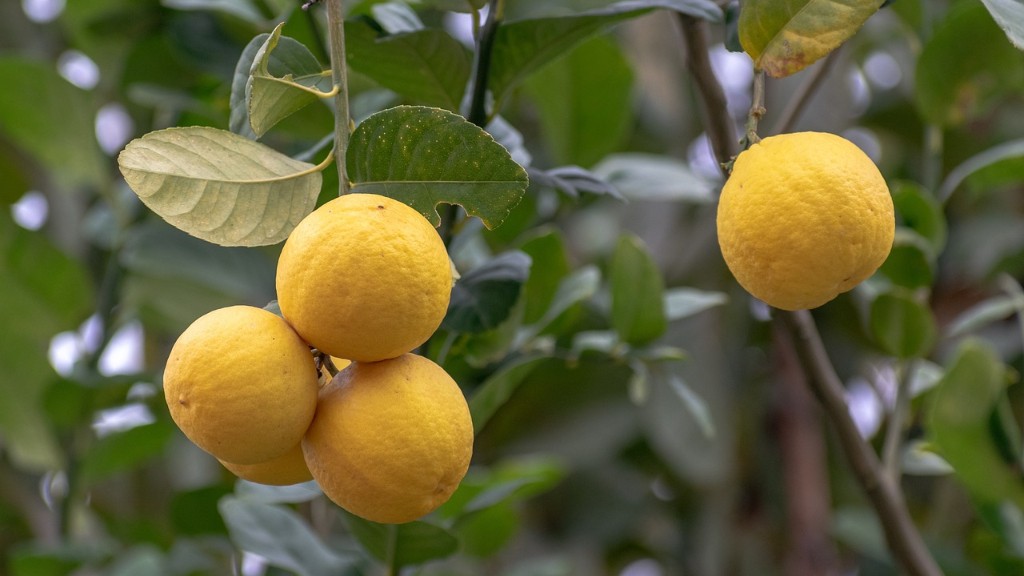Did you know that a lemon tree can reach heights of up to 20 feet? Lemon trees are known for their hardiness and often live for many years. It is interesting to know how big a lemon tree can grow and how much space it can take up in a backyard. When growing a lemon tree, there are a few important things to consider.
The type of lemon tree you plant will determine its size. Dwarf varieties are smaller and can reach up to 10 feet tall, while the standard size can reach heights of 20 feet. It is important to consider the size of your garden or yard and the amount of available space when deciding what type of lemon tree to plant. Another important factor is the amount of sunlight it will receive; a full sun location is ideal.
When planting your lemon tree, make sure you choose a spot that gives it plenty of room to grow and spread its branches. A root-ball or container-grown plant is best as it is easier to transplant. Placing a stake next to the trunk can help encourage the tree to grow straight and strong. Water is an essential part of growth, especially during its first year, so make sure to keep soil well-hydrated but not over-watered.
Consistent pruning is also important to maintain your lemon tree’s shape and size. Pruning helps to encourage new growth and keeps your tree from becoming overly large. After the first year of growth, prune annually for best results. Pruning during spring and fall is ideal, as it doesn’t interfere with the tree’s fruiting cycle.
When properly cared for and maintained, a lemon tree can reach heights of up to 20 feet. To ensure successful growth and keep the tree healthy, location and watering are essential. Furthermore, pruning during spring and fall is beneficial to the tree’s shape and size. With knowledge and attention to care, you can have a flourishing lemon tree in your backyard.
Location
Location is one of the most important factors in determining how big a lemon tree can grow. Lemon trees need full sun, so they should be planted in an area that receives plenty of sunlight. While this might limit their size and shape, it ensures they get the amount of light they need to remain healthy and productive. Placing stakes or cages around the tree can also help to contain its growth.
It’s also important to consider the amount of space you want your lemon tree to occupy and think about the future when deciding its location. A root-ball or container-grown lemon tree is best, as it is easy to transplant. When planting in the ground, make sure to give it enough space to spread its branches and eventually reach its full height.
Finally, choosing a location with good drainage is essential. Lemon trees don’t tolerate overly wet or soggy soil, so make sure to choose a spot where water can properly drain away. Providing the right environment, a lemon tree can reach heights of up to 20 feet.
Watering
Watering is an essential component of keeping your lemon tree healthy and happy. They need to be watered regularly, but not too much, to prevent leaf drop and issues with the roots. When first planting, it is important to water the tree every day and keep the soil slightly moist. After the first year, water deeply once a week, more during times of heat and drought.
Mulching is also beneficial as it helps to retain moisture and inhibits weed growth. A layer of wood chips spread around the base of the tree can keep moisture in and prevent a lot of weeds from appearing. The mulch layer should be 2-3 inches thick and reach the edges of the canopy.
Additionally, regular fertilization can help your lemon tree to grow healthy and happy. Use a nitrogen-rich or citrus fertilizer twice a year and make sure to follow the instructions carefully. Never over-fertilize, as this can severely affect the tree’s growth and fruit production.
Watering is an essential part of keeping a lemon tree healthy, but it needs to be done with care. Deep and consistent watering, combined with fertilization, mulching and sunlight can help your lemon tree reach its full potential.
Pruning
Regular pruning is essential for keeping your lemon tree in check. It encourages new growth, which can help the tree to reach its full potential. By altering the shape and size of the tree, you can control its growth and encourage its health. Prune during spring and fall, as this causes minimal disruption to the tree’s fruiting cycle.
When pruning a lemon tree, it’s important to focus on removing dead, diseased or broken branches. Remove any crossing, rubbing or damaged branches to reduce the risk of diseases spreading. Also, remove any shoots that sprout from the base of the tree, as this helps to keep the tree’s vigor and productivity level.
Finally, prune any branches that are growing away from the tree’s center. This helps to encourage the growth of strong, healthy branches instead of overcrowding the tree and weakening its structure. Pruning also helps to increase air flow, which can help to prevent fungus and disease from appearing.
Pruning can help to maintain the size and shape of your lemon tree, as well as attract pollinators, increase airflow and decrease the risk of fungal diseases. Prune during spring and fall for best results.
Caring for Your Lemon Tree
Caring for a lemon tree can seem daunting at first, but it is an essential component to ensure successful growth. By providing your lemon tree with the right environment, you can ensure it grows strong, healthy and fruitful. The type of tree, location, sunlight and water are all important factors to consider.
It is important to use a root-ball or container-grown type of lemon tree, as they are easier to transplant. When planting, make sure to choose a spot that has plenty of sunlight, good drainage and enough room to grow. Consistent and deep watering is essential, as is regular fertilization. Mulching can also be beneficial, as it helps to keep the soil moist and keeps weeds away.
Finally, regular pruning is necessary to keep your tree healthy and under control. Pruning will encourage new growth and help to maintain the size and shape of the lemon tree. It is best to prune during spring and fall, as this does not interfere with the tree’s fruiting cycle. When done properly and regularly, lemon trees can reach heights of up to 20 feet.
Repotting
Repotting can also help to keep your lemon tree thriving. Once a year, you can give the roots more room to grow and help to promote overall health. Repotting should always be done before the tree has reached its maximum size, as this prevents root constriction. Otherwise, roots may start to curl, making repotting difficult.
When repotting, use a container or potting mix that is specifically designed for citrus trees. Make sure to remove any weeds, dead or diseased roots, and any excess soil from the tree before transferring to a new pot. Use a pot that is one size larger than the original, as this gives the roots enough room to stretch and promote more growth.
Once the tree has been repotted, make sure to water it regularly and keep the soil slightly moist. Additionally, you can use a light but steady stream of water over the roots to help them settle in. After repotting, your lemon tree should be good to go and you can continue to take care of it just as you did before.
Fruit Production
A healthy, strong and properly cared for lemon tree will produce plenty of lemons. To encourage fruit production, make sure to prune regularly and apply a citrus fertilizer every 2 months. Ensure it gets enough sunlight and keep the soil moist but not waterlogged. Also, make sure to watch for any signs of pests or diseases and take care of them quickly.
If you want more lemons, you’ll need to ensure pollination. If your lemon tree is surrounded by other citrus trees, cross-pollination will take care of this issue. If there are no other citrus trees around, you’ll need to use a feather or a soft brush to manually pollinate the tree. Be sure to do this once a week for the best results.
It may take up to two to three years for the tree to start producing fruit. Once it starts, you should get plenty of lemons – up to 200 a season, depending on the type of tree. Remember to water, fertilize and prune regularly, as this will help to keep your tree healthy and happy, resulting in vigorous fruit production.




